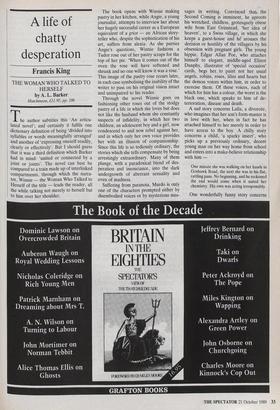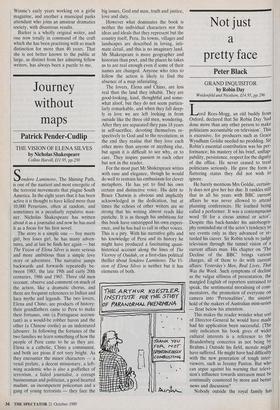A life of chatty desperation
Francis King
THE WOMAN WHO TALKED TO HERSELF by A. L. Barker
Hutchinson, £11.95, pp. 186
The author subtitles this 'An articu- lated novel'; and certainly it fulfils one dictionary definition of being 'divided into syllables or words meaningfully arranged' and another of 'expressing oneself readily, clearly or effectively'. But I should guess that it was a third definition which Barker had in mind: 'united or connected by a Joint or joints'. The novel can best be compared to a train made up of interlinked Compartments, through which the narra- tor, Winnie — the Woman Who Talked to Herself of the title — leads the reader, all the while talking not merely to herself but to him over her shoulder. The book opens with Winnie making pastry in her kitchen, while Angie, a young journalist, attempts to interview her about her hugely successful career as a European equivalent of a griot — an African story- teller who, despite the sophistication of his • art, suffers from alexia. As she parries Angie's questions, Winnie fashions a Tudor rose out of her pastry scraps for the top of her pie. 'When it comes out of the oven the rose will have softened and shrunk and no one will know it was a rose.' This image of the pastry rose recurs later, in each case symbolising the inability of the writer to pass on his original vision intact and unimpaired to his reader.
Through the novel Winnie goes on fashioning other roses out of the stodgy pastry of a life in which she loves but does not like the husband whom she constantly suspects of infidelity, in which her two children, an adolescent boy and a girl, now condescend to and now rebel against her, and in which only her own voice provides her with an illusion of companionship. Since this life is so tediously ordinary, the stories which she tells compensate by being arrestingly extraordinary. Many of them plunge, with a paradoxical blend of des- peration and insouciance, into the dark undergrowth of aberrant sexuality and even of madness.
Suffering from paranoia, Murdo is only one of the characters prompted either by disembodied voices or by mysterious mes- sages in writing. Convinced that- the Second Coming is imminent, he uproots his wretched, childless, grotesquely obese wife from East Grinstead, ter idea of heaven', to a Swiss village, in which she keeps a guest-house and he arouses the derision or hostility of the villagers by his obsession with pregnant girls. The young hippie, Edgar Allan Poe, who attaches himself to elegant, middle-aged Elinor Dunphy, illustrator of 'special occasion' cards, begs her to paint not her usual angels, robins, roses, lilies and hearts but the demon voices within him, in order to exorcise them. Of these voices, each of which for him has a colour, the worst is the black one, which speaks to him of de- terioration, disease and death.
A sad story concerns Lalla, a divorcée, who imagines that her son's form-master is in love with her, when in fact he has attached himself to her merely in order to have access to the boy. A chilly story concerns a child, 'a sparky insect', who picks up a previously ordinary, decent young man on her way home from school and enters into a make-believe relationship with him —
One minute she was walking on her hands in Goshawk Road, the next she was in his flat, rattling pans. No beginning, and he reckoned the end would come when it suited her chemistry. His own was acting irresponsibly.
One wonderfully funny story concerns Winnie's early years working on a girlie magazine, and another a municipal parks attendant who joins an amateur dramatics society, with disastrous results.
Barker is a wholly original writer, and one now totally in command of the craft which she has been practising with so much distinction for more than 40 years. That she is not better known to the public at large, as distinct from her admiring fellow writers, has always been a puzzle to me.



























































 Previous page
Previous page